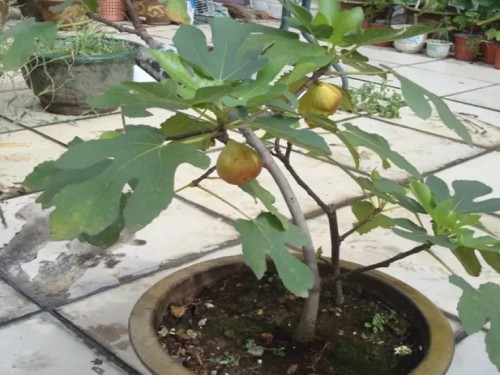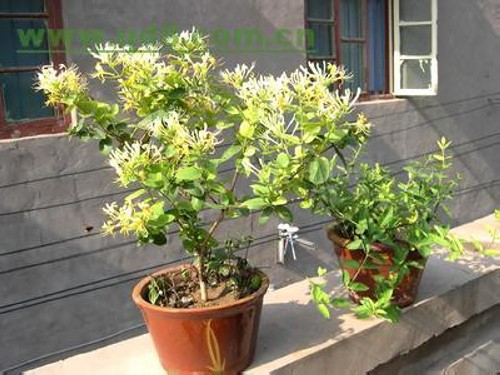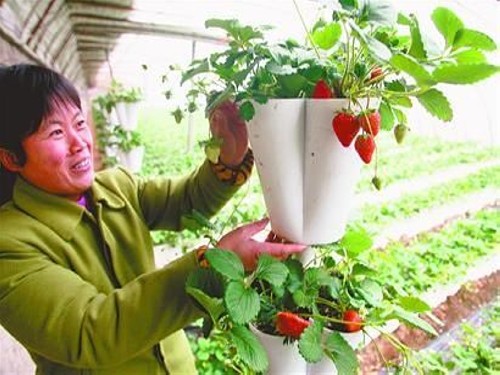Planting techniques of potted figs
Figs are native to the Euro-Mediterranean coast and Central Asia. They were introduced to China in the Western Han Dynasty and have a long history of growing figs in the Tarim Basin. Figs do not bear fruit without flowers, its flowers are solitary, reddish, hidden in the receptacle, inconspicuous. After the fruit is ripe, the flowers fall off, so it is known as figs. The leaves of figs are large, ovate and palmately divided; the crown is round and beautiful, suitable for landscaping and potted ornamental.
Fig, also known as born son, because of its high nutritional value, can not only detoxify, inhibit blood sugar, but also contains a variety of anti-cancer substances. Therefore, together with the mysterious fruit, it is praised by fruit friends as the most worthwhile balcony fruit.
1. Container
There are a variety of containers for potted figs, such as pots, boxes, buckets and so on. The size and quality of the container determine the volume and growth potential of potted roots. Figs are shallow-rooted fruit trees. When planting figs on the balcony, clay pots with a diameter of 40 centimeters and a depth of 25 centimeters are the most suitable.

2. Distribution of soil
Figs do not have high requirements for soil conditions, and they are the most suitable for growth in neutral to alkaline soils with deep, fertile, loose and good permeability. Therefore, the pot soil can be made from 2 parts of sandy loam, 1 part of vermiculite, 1 part of barnyard manure, or 2 parts of garden soil, 2 parts of peat and 1: 2 kg compound fertilizer.
3. Upper basin
Potted figs are generally planted when the spring buds are close to sprouting and the temperature is high, and the survival rate is high at this time. The time of putting on the basin can choose the middle and late March, and it is best to put tiles on the leakage hole pad at the bottom of the basin before going on the basin.
4. Watering
Fig trees are resistant to drought and waterlogging, can be extensive in water management, watering should not be too much, especially in the fruit ripening period, too much water will aggravate fruit cracking.
5. Fertilization
In early June, apply primary diammonium phosphate or potassium dihydrogen phosphate with a dosage of about 0.3 kg. After dissolving with water, pour the fertilizer liquid evenly into the basin. Compound fertilizer containing nitrogen, phosphorus, potassium and trace elements can be applied once in late August, with a dosage of about 0.5 kilogram.
6. Pruning
As the growth rate of fig trees is amazing, potted figs should pay special attention to pruning. When pruning, first, the plant should be short, and it should be truncated at 15cm to 20cm after it is put on the pot. Second, it is necessary to control vegetative growth and cultivate compact trees with dense branches and short branches. In the peak growing season of fruit trees in May and June, pruning methods such as coring, wiping buds and pulling branches were used to control the vigorous growth of branches, so as to cultivate short and sturdy medium and short branches of internodes and increase fruit density.
7. Display
Try to put the tree basin in a well-lit, ventilated place, preferably where the light can reach directly, such as the sunny balcony and the sunny courtyard floor.
Key steps for potted plants:
1. Cushion the drainage hole of the basin bottom with broken basin pieces to facilitate water permeability and air permeability, without losing basin soil, put a small amount of cinder in the basin bottom to facilitate drainage, and then put a few horseshoe slices or broken bone pieces as long-term base fertilizer, and cover the soil with 2-3cm.
2. Load the culture soil in a small half of the basin and make it in the shape of a steamed bun. Put the root of the fig seedling on top, spread the root system, lift the seedling with the left hand, and add the culture soil to the basin with the right hand with a small shovel.
3. After filling the soil, vibrate the flowerpot, gently lift the seedling up to make its root system stretch, then compact the pot soil with your hand and pour it thoroughly. After the water seeps, seal a layer of culture soil, the soil should be lower than the edge of the pot, so that it can be watered later.
4, after planting, put the pot in a sunny place, pay attention to watering to keep the soil moist, basin soil to see dry watering, to less water frequently, which is conducive to germination.
Time: 2019-05-24 Click:
- Prev

Pot technology of honeysuckle: planting technique of potted honeysuckle
Honeysuckle is a temperate and subtropical tree species, which is sunny, shade-tolerant, cold-tolerant, drought-tolerant and moisture-tolerant, and can adapt to both acidic and alkaline soil, but likes loose and fertile neutral sandy loam. It has strong nature, developed root system, strong sprouting ability, light plant, graceful posture and elegant old pile.
- Next

What are organic strawberries? Planting techniques of potted organic strawberries
What are organic strawberries?
Related
- Fuxing push coffee new agricultural production and marketing class: lack of small-scale processing plants
- Jujube rice field leisure farm deep ploughing Yilan for five years to create a space for organic food and play
- Nongyu Farm-A trial of organic papaya for brave women with advanced technology
- Four points for attention in the prevention and control of diseases and insect pests of edible fungi
- How to add nutrient solution to Edible Fungi
- Is there any good way to control edible fungus mites?
- Open Inoculation Technology of Edible Fungi
- Is there any clever way to use fertilizer for edible fungus in winter?
- What agents are used to kill the pathogens of edible fungi in the mushroom shed?
- Rapid drying of Edible Fungi

